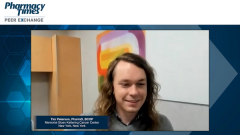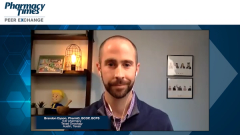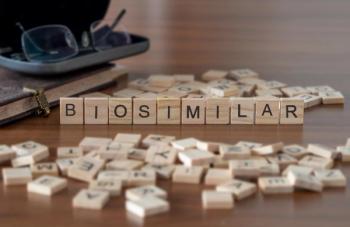
Impact of COVID-19 on Adoption of Biosimilars
The impact of the COVID-19 pandemic on the rate of biosimilar adoption in clinical practice, updates to NCCN guideline recommendations, and financial implications associated with the utilization of biosimilars.
Episodes in this series

Bhavesh Shah, RPh, BCOP: Tim, how has COVID-19 impacted the adoption of biosimilars in your practice?
Tim Peterson, PharmD, BCOP:As I mentioned previously, we had started our biosimilar pathway—the incorporation of therapeutic and supportive care biosimilars—about a year and a half or 2 years ago, so we were pretty well established within the MSK [Memorial Sloan Kettering Cancer Center] system. But more broadly, when you think about other institutions that may have been dragging their feet for incorporation of biosimilars, this is really going to light a fire under them. We’ve realized that there are significant financial toxicities that everyone has experienced, and these are going to persist for many years after the pandemic has hopefully settled down. We know there are significant cost savings to be had by biosimilars, up to 30%, depending on the scenario. I believe this is going to lead a lot of institutions toward more rapid incorporation than we may have expected. But also a caveat to that, I know Brandon brought up the Neulasta [pegfilgrastim] Onpro [on-body injector] device. So the incorporation of biosimilars is going to depend on which biosimilar is in question too.
In terms of the supportive care context, for us, we saw a decrease in pegfilgrastim biosimilar use because we were giving Onpro devices to many more patients when we wouldn’t have really been considering it, because we wouldn’t have a need to. We had many providers that were for good reason trying to reduce exposure risk for patients that are immune suppressed, so we were using the Neulasta Onpro device that doesn’t have a biosimilar, clearly, in lieu of pegfilgrastim biosimilars that we may have used. Those companies that develop pegfilgrastim biosimilars have already been public with the fact that their market share is much lower than they expected, and that’s almost entirely because of Onpro and the pandemic. It’s going to depend on the biosimilar in question, but thinking broadly, we’re going to see a lot more rapid incorporation of them.
Bhavesh Shah, RPh, BCOP:I’m wondering if these changes that we’re also seeing are driven not only financially but by national guidelines too. Brandon, do you want to talk about changes you’ve seen from the national guidelines that may be driving this?
Brandon Dyson, PharmD, BCOP, BCPS:The NCCN [National Comprehensive Cancer Network] Guidelines have a whole page dedicated to COVID-19 for temporary recommendations due to COVID-19. If you go look at the supportive care guidelines, they live on their own page. You have to find them or know that they’re there. Previously, you wouldn’t do primary prophylaxis with pegfilgrastim, or with filgrastim for that matter, unless the risk of febrile neutropenia was greater than 20%. That was the cutoff. They’ve eased that to roughly 10% to 20%, so now that’s opening up for more patients to potentially get pegfilgrastim. But to go back to what Tim just said, it’s also pushing us to use the Onpro device to reduce clinic traffic. We’re trying to prevent that day to come in for clinic. So it’s yes and no. They’re actually quite extensive, these recommendations, but pushing toward oral therapies and certain things like using capecitabine-oxaliplatin instead of using FOLFOX [5-fluorouracil, leucovorin, oxaliplatin] for eligible patients. So they’ve opened up a little. They have a lot of recommendations for other things such as using extended interval dosing, like 6-week for Keytruda [pembrolizumab] and 4-week for Opdivo [nivolumab] dosing, but that doesn’t really impact biosimilars per se. To echo what Tim said, the biggest thing COVID-19 will have is, because of the cost savings if nothing else, organizations that were dragging their feet on implementing biosimilars will implement biosimilars. You’ll start selecting therapies and treatments that might reduce risk or might reduce clinic visits, at least in the short term.
Bhavesh Shah, RPh, BCOP:There are definitely financial and clinical implications. Obviously, NCCN Guidelines are driving some of this utilization. But we’re also seeing more utilization of nonbiosimilars because of guidelines shifting. As you said, COVID-19 has a lot to do with many of these shifts, and we are seeing this acceleration of adoption of biosimilars. In terms of understanding what type of financial implications this actually provides, Ryan, perhaps you can talk about the implications from that in your practice?
Ryan Haumschild, PharmD, MS, MBA:Absolutely. There are a lot of financial implications that we’ve been figuring out as COVID-19 is gone. Spacing out an infusion center is a great example. We’re so used to booking all our chairs, and we budget per chair in terms of chair turnover for the number of patients we can get in. As we start to space out our infusion center, it does impact our bottom line. We’ve got to get creative—how do we extend therapy to maybe home infusion? We talked about utilization trends, and it’s interesting to hear my colleagues talk about the on-body injector. We’ve pulled out that file and dusted off the same-day injection of pegfilgrastim and started looking at that data again instead of looking at just on-body.
How can we become innovative where the patient comes, they get everything in the same day, and we don’t have to worry about any on-body failures? Those are things that we’ve seen, because if a patient has a failure on on-body, has neutropenic fever and hits our ED [emergency department], we’re already at capacity. Those are things that we’re really looking at closely. Lastly, in terms of the utilization of biosimilars, reducing the total cost of care has been huge. We’ve seen an increase. Inherently our drug budgets have gone up, and we’ve seen this being utilized even more in the inpatient population, so we can decrease drug expense as we onboard new and innovative COVID-19 therapy. I would say to an extent, Bhavesh, it’s shifting the finances into the ambulatory and home infusion world, and it’s forcing us to be creative in utilizing biosimilars to reduce cost but still capture those patients in a really productive and thoughtful manner.
Bhavesh Shah, RPh, BCOP:Very well put. Thank you so much, Ryan.
Transcript edited for clarity.
Newsletter
Stay informed on drug updates, treatment guidelines, and pharmacy practice trends—subscribe to Pharmacy Times for weekly clinical insights.

















































































































































































































